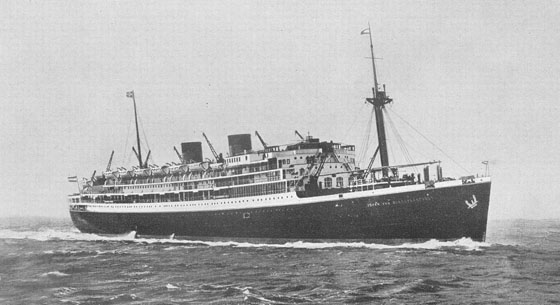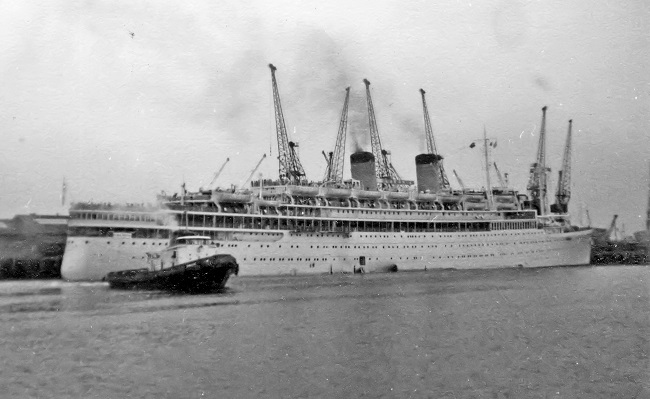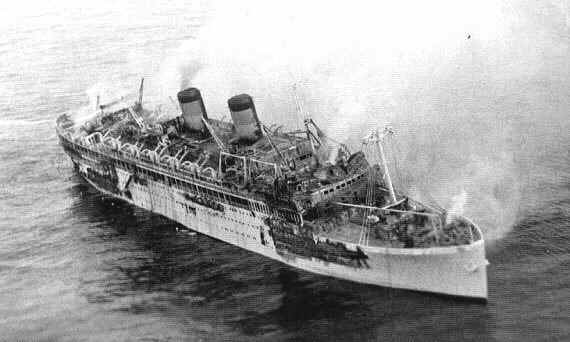
The construction of the 'Johan Van Oldenbarnevelt' commenced during June 1928, with launching taking place on August 3rd 1929 under the auspices of Mrs Tegelberg-Hooft, wife of a director of the Netherland's Line. This was currently the largest Dutch ship built and at that time the most luxurious to work the route to the Dutch East Indies. Her sea trials took place during March 1930 in the North Sea - the engines were tested upto a maximum of 115rpm produing a maximum speed of 19 knots.
The ship was fitted with a considerable capacity for the transport of refridgerated goods & stores, either for use on the ship or as part of its cargo. The Johan Van Oldenbarnevelt would frequently sail routes through the Red Sea where the water temperature could reach as high as 95F and would carry supplies that could not be replenished at the ports en-route so the need for adequate refridgeration onboard was critical. The ship contained nineteen cold rooms with a total capacity of 19,000 cubic feet. To supply these rooms and provide cooling for drinking water, ice making and air cooling two Sulzer ammonia compressors were part of the ship's machinery. The compressors were rated at 240,000 BTU/hour with an evaporating temperature of 5F and a condensing temperature of 115F, with service at least eighteen hours per day.
The maiden voyage was to have taken place on May 6th 1930, but whilst navigating the North Sea canal, sailing towards Ijmuiden the ship collided with the Reggestroom, a 3,854 ton freighter. The minor damage to the starboard side was quickly repaired, quick enough to allow the ship to sail shortly afterwards. By the time the ship had reached Port Said she was back on the timetable originally established for the maiden voyage to the Dutch East Indies. This route took the ship from Amsterdam to Genoa, then through the Suez Canal and on to her destination of Batavia (Djakarta). This ship would ply this route for the next nine years until World War Two broke out in 1939.

At the outbreak of World War Two the ship was re-registered in Batavia, being used on the Java - New York run principally carrying cargo. In January 1941 the ship was acquired by the Allied Powers, being sent to Harland & Wolff (Belfast?) for conversion into a troopship, now configured to carry 4,000 troops. When Batavia fell to the Japanese the ship's port of registration moved to Willemstad Curacao.
On March 24th 1941 the Johan Van Oldenbarnevelt sailed from the United Kingdom as part of convoy WS7 for Suez via Cape Town. The convoy reached Freetown about April 4th 1941 and sailed from here on April 7th 1941. Cape Town was reached on April 16th 1941 and Durban by April 19th 1941. Four ships including the Johan Van Oldenbarnevelt were detached in the Indian Ocean to become convoy WS 7X bound for Bombay where they arrived on May 5th 1941.
On March 23rd 1942 the Johan Van Oldenbarnevelt sailed from the United Kingdom as part of convoy WS 17 bound for Suez. After arrival at Freetown the convoy split into four parts with the Johan Van Oldenbarnevelt being part of convoy WS 17B, sailing from Freetown on April 11th 1942. Cape Town was reached April 23rd 1942. After the convoy rejoined it sailed northwards until split into two parts, one group bound for Aden & Suez, the other group for Bombay. This latter group included the Johan Van Oldenbarnevelt, now sailing in convoy WS 17B. Bombay was reached on May 16th 1942.
The Johan Van Oldenbarnevelt sailed from the United Kingdom on August 29th 1942 as part of convoy WS 22, also sailing in the convoy was the Sulzer powered Rangitata. Freetown was reached on September 9th 1942, departure was on September 13th 1942, joining the convoy at Freetown was the Sibajak, another Sulzer engined ship. The convoy reached Cape Town on September 25th 1942 with the Johan Van Oldenbarnevelt stopping here to refuel, departing on September 29th 1942. Near Durban the convoy was joined by several other ships including the Sulzer engined Felix Roussel & Indrapoera! These five ships would not remain together long, the Johan Van Oldenbarnevelt arrived at Bombay on October 17th 1942, the others split between Aden/Suez & Mombasa.
Joint convoy WS 28 & KMF 11 sailed from the United Kingdom on March 16th 1943 including the Rangitata & the Johan Van Oldenbarnevelt. On March 21st 1943 the convoys split with KMF 11 heading into the Mediterranean which included the two Sulzer engined ships.
The Indrapoera and the Johan Van Oldenbarnevelt sailed as part of joint convoys WS 30 & KMF 15 from the United Kingdom on May 21st 1943. On May 25th 1943 the convoys split, the KMF 15 heading into the Mediterranean with the two aforementioned ships.
On August 17th 1943 the last of the WS convoys, WS 33 sailed from the United Kingdom, it included the Indrapoera. The convoy reached Durban on October 13th 1943. Seven days were spent at Durban before the convoy moved on to Kilindini, arriving on October 26th 1943 and remaining here just one day. Three days later (30th) the convoy divided with the Bombay section including the Indrapoera and the Johan Van Oldenbarnevelt (from ?), reaching Bombay on November 4th 1943. This convoy was the last of the WS (Winston Special) series, the opening up of the Mediterranean to Allied forces made the long trip around Africa redundant.
The ship survived the hostilities, but remained in use after war's end to repatriate troops, bringing home 3,668 troops on a trip from Bombay to Southampton, arriving on October 29th 1945 amid much fanfare. Brief repairs were carried out before sailing in mid-December to India, Singapore & Penang. On her return voyage the ship was received by her home port, Amsterdam - by mid March 1946 the ship had been handed back to the Dutch Government.
An overhaul was carried out, after which the ship entered service on the Amsterdam - Indonesia service, besides the regular fare paying passengers the ship carried many Dutch troops used in the worsening crisis in the Dutch East Indies. Such was the extent of the political situation that from September 1950 the Johan Van Oldenbarnevelt was transferred to the Australia/New Zealand service, running via Cape Town. She would ply this route for the next twelve years. Whilst on this service a refit was undertaken during 1952, the passenger configuration changed to a one-class ship. On the first voyage out after the refit, January 23rd 1952 a number of fires were discovered whilst navigating the English Channel. The ship returned to Amsterdam, because the fires were of a suspicious nature the ship's next sailing included members of the Dutch Maritime police on board. Although primarily worked on the Australia run occasional North Atlantic sailings took place.
The collision of the William Ruys & the Oranje in the Red Sea during January 1953 saw the Johan Van Oldenbarnevelt hired to substitute for the Williem Ruys for one Europe - Djakarta round trip.
With loadings declining the ship was then used to operate the World Service, receiving a three month refit in Amsterdam during 1959 for this purpose. This refit produced some very noticeable changes to the ship's outline, most prominent was the increased height of the funnels and the loss of the main mast. In her round-the-world service the ship usually worked the eastward route. The first journey commenced on April 2nd 1959 from Amsterdam calling at Southampton, Port Said, Suez, Aden, Freemantle, Melbourne, Sydney & Wellington - total journey time was forty one days. The return journey was via Papeete, Panama Canal, Port Everglades, Bermuda, Southampton & Amsterdam. Additionaly the Trans Tasman cruises were operated from 1959 - 1963 during December through February.
By 1962 the decision had been made to curtail the world service operated by the Johan Van Oldenbarnevelt due to falling passenger loadings. The last eastbound voyage commenced at the end of September, arriving in Wellington on November 9th 1962. A trip was made to Perth to support the 7th Commonwealth Games, returning to Wellington to take up the last season of the Trans Tasman cruises. After completing these tours the ship sailed one last time with passengers from Wellington to Sydney. After arriving on February 3rd 1963 the passengers were disembarked, the ship de-commissioned, leaving Sydney later that day for Genoa via the Indian Ocean and Suez Canal.
After arrival in Genoa the ship received a refit at Officine Mariotti for her new owners the Goulandris Greek Line. Rejuvenated and now named 'Lakonia' the ship provided a variety of cruises in the Mediterranean and eastern Atlantic, calling at such ports as Madeira, Le Havre, Tenerife, Las Palmas, Lisbon, Vigo, Tangiers, Casablanca, Malaga & Cadiz. Performance problems experienced throughout the 1963 cruise season led to drydocking at Southampton late in 1963. Thorneycrofts changed the engines fuel injection system from air blast to pneumatic as well as a number of cosmetic changes about the vessel.

With repairs complete the ship prepared to sail on an eleven day cruise over the Christmas season to Madeira, Tenerife & Las Palmas before returning to Southampton. The cruise began on December 19th 1963 with 646 passengers and 376 crew. Late in the evening of December 22nd a fire was reported on board the ship, coming from the barbershop area. Attempts to quell the fire failed and eventually the fire spread enough to give the order to abandon ship. The evacuation did not go too smoothly, with a number of lifeboats not launching correctly, leaving approximately two hundred passengers stranded on the ship. The SOS went out about ninety minutes after the fire was discovered, by 3.30am the next morning an Argentinian passenger vessel, the 'Salta' was on scene and rescued the majority of the passengers and crew of the Lakonia.
Those passengers remaining on the ship, facing the spreading fire and an increasing list did what they could to leave the ship, often with tragic results, resulting in the loss of 128 lives. Six other vessels would eventually assist in the rescue.

On December 24th Dutch, Norwegian and Naval tugs were alongside the still burning vessel and were successful in attaching tow ropes, with the intent to tow the ship to Gibralter. For five days the tow was successful, unfortunately worsening weather led to an increased list, the ship started taking on water, shortly after noon on December 29th 1963 the ship heeled over on her starboard side and slipped beneath the waves.
Details:
Builder: Netherland Shipbuilding Co, Amsterdam
Commissioned: May 1930
Length: 608 feet
Beam: 74.8 feet
Depth: 55feet
Gross Weight: 19,040 tons; 19,787 tons after 1952 refit; 20,314 tons after 1959 refit; 20,238 tons after 1963 refit.
Engines (Primary): Two x Sulzer (Winterthur) 10ST76 engines of 7,000 bhp at 100rpm - ten cylinder, 760mm bore x 1,340mm stroke.
Engines (Auxiliary): Three 6SS38 engines at 760 bhp at 170rpm, one 6RKH30 300 bhp at 300rpm.
Screws: Two
Maximum speed: 19 knots
Passengers: 327 1st class, 274 2nd class, 64 3rd class, 48 4th class (a number of 1st, 2nd, 3rd class cabins were interchangeable so numbers might vary); 1,414 one-class after 1952 refit; 1,210 on-class passengers after 1959 refit.
Page added February 12th 2005.
Last updated January 23rd 2016.
Return to Ship menu
Return to site menu